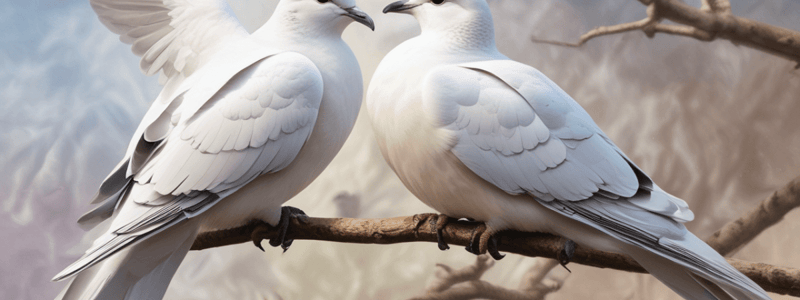Podcast
Questions and Answers
What percentage of dove species are at risk of becoming endangered?
What percentage of dove species are at risk of becoming endangered?
- 40%
- 70%
- 50%
- 60% (correct)
What is unique about the way doves feed their babies?
What is unique about the way doves feed their babies?
- Both parents produce a type of milk to feed the babies. (correct)
- Only the female dove feeds the babies.
- The babies feed themselves from birth.
- Both parents feed the babies, but only with insects.
What can happen if one dove invades another's territory?
What can happen if one dove invades another's territory?
- They become friends.
- The intruder may be attacked and killed. (correct)
- They ignore each other.
- They mate for life.
What is a common symbolic meaning associated with doves in many religions and cultures?
What is a common symbolic meaning associated with doves in many religions and cultures?
What is the size of the largest dove in the family?
What is the size of the largest dove in the family?
What is unique about the wings of doves?
What is unique about the wings of doves?
What is a unique characteristic of different dove species' calls?
What is a unique characteristic of different dove species' calls?
What is true about the habitat of doves?
What is true about the habitat of doves?
How many eggs do female doves typically lay at a time?
How many eggs do female doves typically lay at a time?
What is a concern for some species of doves?
What is a concern for some species of doves?
Flashcards are hidden until you start studying
Study Notes
Doves and Their Symbolism
- Symbol of peace in many religions and cultures
- Used to represent God in Christian religion
- Released into the sky at ceremonies, weddings, and important events
Habitat and Distribution
- Found all over the world, except Antarctica
- Hardy birds that can live in desert areas, tropical forests, mountains, and woodlands
- Eat insects, seeds, nuts, and fruits, and almost anything in areas where people feed them
Breeding and Life Cycle
- Females lay two eggs at a time
- Eggs hatch in a few weeks
- Most doves live around 3-5 years in the wild, but longer in captivity
Doves and Pigeons
- Both belong to the Columbidae scientific family
- Pigeons are usually bigger and gray, while doves are smaller and white with long tail feathers
- 300 species of doves, each with unique characteristics
- Most species have small heads, pointed bills, rounded bodies, long wings, and tail feathers
Conservation
- 60% of dove species are at risk of becoming endangered
- Threats include new predators, hunting, and habitat loss due to development and deforestation
- Some species have become extinct over the years
Fun Facts
- Each dove species has a slightly different coo sound
- Doves are found in large numbers in Australia and parts of Asia
- Both male and female doves produce milk to feed their babies
- Some species mate for life
- Doves can be aggressive towards each other, with territorial invasions leading to attacks and death
- Largest dove species is the Victoria crowned pigeon, reaching 2-3 feet long
- Smallest dove species is the pygmy ground dove, reaching 6 inches long
Studying That Suits You
Use AI to generate personalized quizzes and flashcards to suit your learning preferences.



